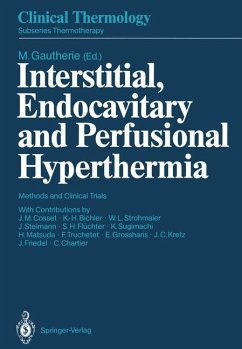
Interstitial and Intracavitary Thermoradiotherapy
Versandkostenfrei!
Versandfertig in 1-2 Wochen
77,99 €
inkl. MwSt.

PAYBACK Punkte
39 °P sammeln!
The use of hyperthermia in radiation oncology is well established. Many publications cover the whole field of possibilities and problems of this therapeutic modality. The new development of interstitial and intracavitary hyperthermia, however, is not well known: there are only a few relevant publications in different journals. Therefore, it was appropriate that SAUER and SEEGENSCHMIEDT organized an international meeting on this topic, where experiences with this new and promising technique were compiled and discussed by experts. The papers of this symposium together with additional review pape...
The use of hyperthermia in radiation oncology is well established. Many publications cover the whole field of possibilities and problems of this therapeutic modality. The new development of interstitial and intracavitary hyperthermia, however, is not well known: there are only a few relevant publications in different journals. Therefore, it was appropriate that SAUER and SEEGENSCHMIEDT organized an international meeting on this topic, where experiences with this new and promising technique were compiled and discussed by experts. The papers of this symposium together with additional review papers and clinical studies are published in this volume. The publication begins with the physical and biological background of interstitial and intracavitary hyperthermia continues with comprehensive review papers on clinical topics and then gives examples for a wide variety of clinical applications. This volume will contribute to better understanding and application of the treatment possibilities of radio oncology in combination with this new treatment modality.












